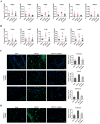Therapeutic effects of axitinib, an anti-angiogenic tyrosine kinase inhibitor, on interstitial cystitis
- PMID: 37221266
- PMCID: PMC10205792
- DOI: 10.1038/s41598-023-35178-5
Therapeutic effects of axitinib, an anti-angiogenic tyrosine kinase inhibitor, on interstitial cystitis
Abstract
To investigate the therapeutic effects of axitinib, a tyrosine kinase inhibitor, in an interstitial cystitis (IC) rat model. IC patients with or without Hunner lesion and non-IC controls were enrolled (n = 5/group). Bladder tissues were stained with vascular endothelial growth factor (VEGF), VEGF receptor 2 (VEGFR-2), platelet-derived growth factor (PDGF), and PDGF receptor B (PDGFR-B). The IC group showed extensive VEGFR-2 and PDGFR-B staining compared with controls. Next, ten-week-old female Sprague Dawley rats were divided into three groups (n = 10/group): sham, hydrochloride (HCl), and axitinib groups. One week after HCl instillation (day 0), the axitinib group received oral axitinib (1 mg/kg) for five consecutive days and pain was evaluated daily. Bladder function, histology and genetics were evaluated on day 7. The pain threshold significantly improved 3 days after axitinib administration. Axitinib decreased non-voiding contraction and increased the micturition interval and micturition volume and alleviated urothelial denudation, angiogenesis, mast cell infiltration, and fibrosis. HCl instillation increased the expression of tyrosine kinase receptors, including VEGFR-2 and PDGFR-B; axitinib administration inhibited their expression. Oral administration of axitinib improved pain, voiding profiles, and urothelial integrity by inhibiting angiogenesis in IC rat model. Axitinib may have potential therapeutic efficacy in IC patients.
© 2023. The Author(s).
Conflict of interest statement
The authors declare no competing interests.
Figures





Similar articles
-
Angiogenesis in bladder tissues is strongly correlated with urinary frequency and bladder pain in patients with interstitial cystitis/bladder pain syndrome.Int J Urol. 2019 Jun;26 Suppl 1:35-40. doi: 10.1111/iju.13972. Int J Urol. 2019. PMID: 31144750
-
Combined VEGF and PDGF inhibition for neovascular AMD: anti-angiogenic properties of axitinib on human endothelial cells and pericytes in vitro.Graefes Arch Clin Exp Ophthalmol. 2017 May;255(5):963-972. doi: 10.1007/s00417-017-3595-z. Epub 2017 Feb 4. Graefes Arch Clin Exp Ophthalmol. 2017. PMID: 28161830
-
Cultured versus freshly isolated adipose-derived stem cells in improvement of the histopathological outcomes in HCL-induced cystitis in a rat model.Biomed Pharmacother. 2022 Sep;153:113422. doi: 10.1016/j.biopha.2022.113422. Epub 2022 Jul 19. Biomed Pharmacother. 2022. PMID: 36076544
-
Phenotyping of interstitial cystitis/bladder pain syndrome.Int J Urol. 2019 Jun;26 Suppl 1:17-19. doi: 10.1111/iju.13969. Int J Urol. 2019. PMID: 31144756 Review.
-
Pathology and terminology of interstitial cystitis/bladder pain syndrome: A review.Histol Histopathol. 2019 Jan;34(1):25-32. doi: 10.14670/HH-18-028. Epub 2018 Jul 17. Histol Histopathol. 2019. PMID: 30015351 Review.
Cited by
-
Axitinib targets cardiac fibrosis in pressure overload-induced heart failure through VEGFA-KDR pathway.Front Med (Lausanne). 2023 Nov 10;10:1256156. doi: 10.3389/fmed.2023.1256156. eCollection 2023. Front Med (Lausanne). 2023. PMID: 38020087 Free PMC article.
-
Promising Experimental Treatment in Animal Models and Human Studies of Interstitial Cystitis/Bladder Pain Syndrome.Int J Mol Sci. 2024 Jul 23;25(15):8015. doi: 10.3390/ijms25158015. Int J Mol Sci. 2024. PMID: 39125584 Free PMC article. Review.
References
Publication types
MeSH terms
Substances
LinkOut - more resources
Full Text Sources
Medical
Miscellaneous

